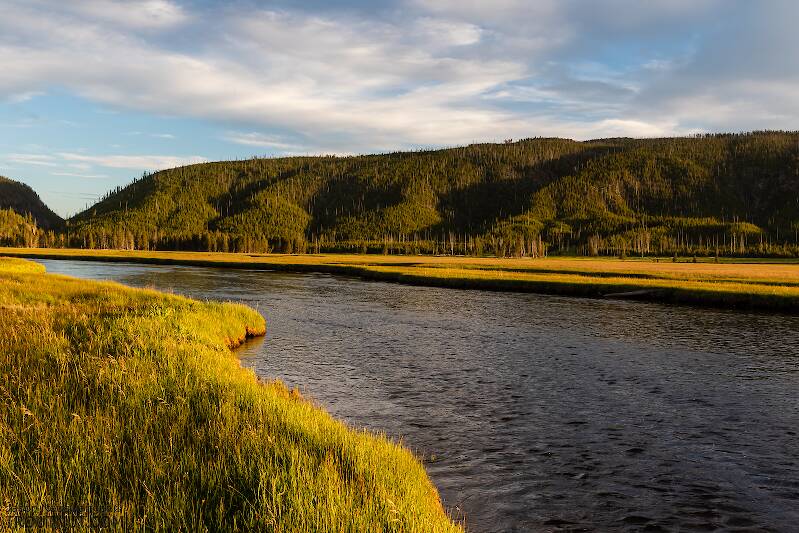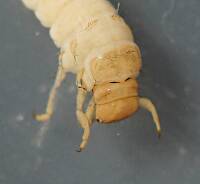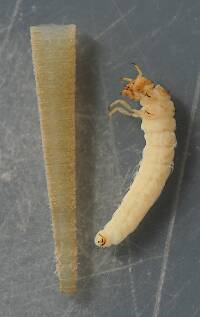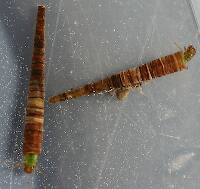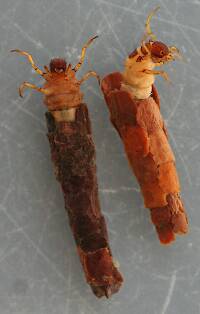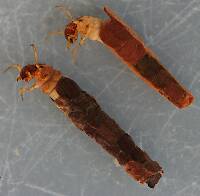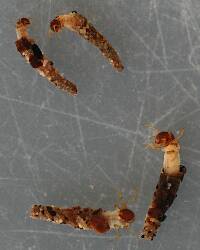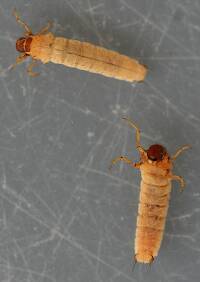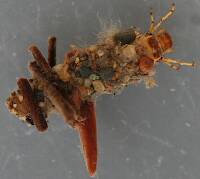
Blue-winged Olives
Baetis
Tiny Baetis mayflies are perhaps the most commonly encountered and imitated by anglers on all American trout streams due to their great abundance, widespread distribution, and trout-friendly emergence habits.
Featured on the forum

Nymphs of this species were fairly common in late-winter kick net samples from the upper Yakima River. Although I could not find a key to species of Zapada nymphs, a revision of the Nemouridae family by Baumann (1975) includes the following helpful sentence: "2 cervical gills on each side of midline, 1 arising inside and 1 outside of lateral cervical sclerites, usually single and elongate, sometimes constricted but with 3 or 4 branches arising beyond gill base in Zapada cinctipes." This specimen clearly has the branches and is within the range of that species.

Troutnut is a project started in 2003 by salmonid ecologist Jason "Troutnut" Neuswanger to help anglers and
fly tyers unabashedly embrace the entomological side of the sport. Learn more about Troutnut or
support the project for an enhanced experience here.
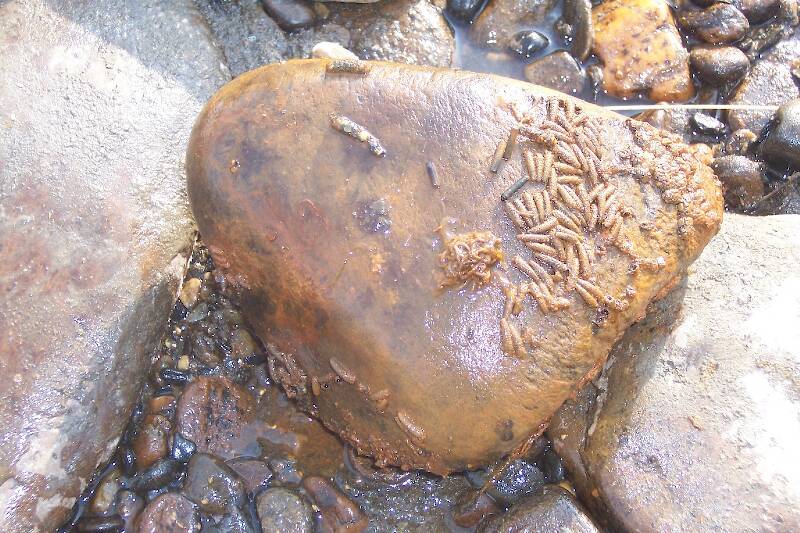
Hallofthe
Posts: 7
Posts: 7
Hallofthe on Apr 26, 2008April 26th, 2008, 3:04 pm EDT
I am sending one picture as a test. I took this photo on the Chena River a few days ago. It's still cold and snowing, but this section has a spring with iron deposits a shown by the red stain on the rock. I can see about five different types of cases. I assume caddis? I am trying to get a handle on what aquatic insects are present here.
Thanks, Tiff
Thanks, Tiff
Taxon on Apr 26, 2008April 26th, 2008, 6:07 pm EDT
Tiff-
I've cropped two sections of your rock, and annotated what I believe to be (at least) six different varieties of caddisfly cases, so we refer to them with a little more precision.


My guesses as to genus are as follows, but hopefully this will at least spur on others to contribute their better knowledge:
A -
B - Oecetis
C - Dicosmoecus
D -
E -
F -
I've cropped two sections of your rock, and annotated what I believe to be (at least) six different varieties of caddisfly cases, so we refer to them with a little more precision.


My guesses as to genus are as follows, but hopefully this will at least spur on others to contribute their better knowledge:
A -
B - Oecetis
C - Dicosmoecus
D -
E -
F -
Troutnut on Apr 26, 2008April 26th, 2008, 8:54 pm EDT
Taxon's guesses look good to me. I'll probably have closeups of all those species from the Chena later this summer. I'm going to be working day in and day out on that river.
Jason Neuswanger, Ph.D.
Troutnut and salmonid ecologist
Troutnut and salmonid ecologist
Creno on Apr 27, 2008April 27th, 2008, 1:46 pm EDT
I would guess:
A - Brachycentrus?
B - Perhaps a leptocerid (Oecetis/Ceraclea) but if Brachycentrus is correct then B seems too big for a leptocerid and the case is not tapered/curved enough. Perhaps an apataniid but seems big for that as well so likely another limnephilid.
C - I don't think this form, which also appear on the upper left of the rock, is Dicosmoecus. The hoodlike anterior of Dicosoecus should be obvious and I cannot see it. Given the challenged water quality, how about Hesperophylax?
D - Chironomidae?
E - more of B?
F - on the upper right corner of the original photo there is a typical Glossosoma pupation aggregation.
Dave
A - Brachycentrus?
B - Perhaps a leptocerid (Oecetis/Ceraclea) but if Brachycentrus is correct then B seems too big for a leptocerid and the case is not tapered/curved enough. Perhaps an apataniid but seems big for that as well so likely another limnephilid.
C - I don't think this form, which also appear on the upper left of the rock, is Dicosmoecus. The hoodlike anterior of Dicosoecus should be obvious and I cannot see it. Given the challenged water quality, how about Hesperophylax?
D - Chironomidae?
E - more of B?
F - on the upper right corner of the original photo there is a typical Glossosoma pupation aggregation.
Dave
Hallofthe
Posts: 7
Posts: 7
Hallofthe on Apr 27, 2008April 27th, 2008, 5:12 pm EDT
Roger, Jason,and Dave,
Thank you for you're rapid and informative response. I will look these caddis up in my Western Hatches and tie up some flies to match. Not that its critical to match the hatch for grayling, but its fun anyway! Now that I am retired I will be spending even more time up Chena Hot Springs Road enjoying the river and chasing grayling. I will send more pictures as the season progresses ( i hope it progresses this year? We're off to a very slow start.).
Thanks, Tiff
Thank you for you're rapid and informative response. I will look these caddis up in my Western Hatches and tie up some flies to match. Not that its critical to match the hatch for grayling, but its fun anyway! Now that I am retired I will be spending even more time up Chena Hot Springs Road enjoying the river and chasing grayling. I will send more pictures as the season progresses ( i hope it progresses this year? We're off to a very slow start.).
Thanks, Tiff
Creno on Apr 28, 2008April 28th, 2008, 2:33 pm EDT
Tiff - what are the chances you would go back to that rock (or a nearby rock)and put the cases in bottle? It would be great, and educational, to take a look at the critters up close to see what they really are. If you want I can send you some vials. It is best if you can get ETOH for a preservative.
dave
dave
Hallofthe
Posts: 7
Posts: 7
Hallofthe on Apr 29, 2008April 29th, 2008, 4:52 am EDT
Dave,
I can do that. What kind of preservative is ETOH? If it is not common I may be able to get it, as well as vials at the Univ. of Alaska stock room.
Tiff
I can do that. What kind of preservative is ETOH? If it is not common I may be able to get it, as well as vials at the Univ. of Alaska stock room.
Tiff
GONZO on Apr 29, 2008April 29th, 2008, 5:39 am EDT
Tiff, EtOH is ethanol (grain alcohol). I'm sure the U of A has a good supply on hand, but you can also find denatured alcohol at most drugstores.
Shawnny3 on Apr 29, 2008April 29th, 2008, 1:01 pm EDT
but you can also find denatured alcohol at most drugstores.
...or in most bottles of bad moonshine. Don't drink that denatured stuff, though, no matter how lonely it gets up there.
-Shawn
Jewelry-Quality Artistic Salmon Flies, by Shawn Davis
www.davisflydesigns.com
www.davisflydesigns.com
Getyourbone on Apr 29, 2008April 29th, 2008, 4:25 pm EDT
Hey, Wouldn't these be considered Juvenile? I believe it is illegal to give them alcohol. Shame on you!
Hallofthe
Posts: 7
Posts: 7
Hallofthe on Apr 30, 2008April 30th, 2008, 7:14 am EDT
With the way winter keeps going on and on and on I think the aquatic insects as well as my self are about to take up alcohol.
Tiff
Tiff
Creno on Apr 30, 2008April 30th, 2008, 7:24 am EDT
Tiff - 80 to 100% ethyl alcohol is probably best for initial preservation of most aquatic insects, even if they are juveniles :) I don't recommend denatured alcohol as often one never knows what it was denatured with (e.g. aviation gasoline, methanol, etc.). Depending on the denaturing compound the specimens may become very brittle and fall apart over time. I also don't recommend isopropyl alcohol (common rubbing alcohol) because it also makes specimens brittle and difficult to process. This is especially true for adults which often must be processed further to make species determinations. And the denaturing compounds are often worse than ethyl alcohol for the taxonomist.
Another approach if you cannot get good ethyl alcohol is to simply freeze them. Just drain off most of the water and place in a baggie and into the freezer. They are fragile in this condition and can be easily crushed but they can be thawed later and properly preserved.
In the case of the critters on the rock it appeared that many of them had pupated. That can be a great opportunity for the taxonomist or a disaster. As the critters molts from the larval through the pupal to the adult stage it goes through some amazing changes. All of its tissues change shape/structure several times. If one preserves the critter when it is between these stages one is often left with little but mush for a determination. Specimens like this are pretty much useless. But, for most species, these mush stages are very brief.
If you have the time you can carefully remove the pupae from the rock without crushing them and place them in a baggie/jar with a little bit of damp moss. Put different kinds of cases into different baggies and do not leave enough water in the bag to cover the pupae. They usually do real good with just enough water to keep the air in the bag moist. Close the bag puffed up with lots of air in it. Then put the bag in the beer cooler/fridge and wait. Every day or so take a look and see if an adult has emerged. If so, place everything into a single vial of 100% ethyl alcohol. If a couple weeks goes by and nothing happens just preserve everything. This is one of the best types of taxonomic collection you can make as you end up with the larval/adult association. And the fishermen get an adult for the fly pattern. There are more details to this method to get better success and if you want more just send me a PM.
Hope this helps.
dave
Another approach if you cannot get good ethyl alcohol is to simply freeze them. Just drain off most of the water and place in a baggie and into the freezer. They are fragile in this condition and can be easily crushed but they can be thawed later and properly preserved.
In the case of the critters on the rock it appeared that many of them had pupated. That can be a great opportunity for the taxonomist or a disaster. As the critters molts from the larval through the pupal to the adult stage it goes through some amazing changes. All of its tissues change shape/structure several times. If one preserves the critter when it is between these stages one is often left with little but mush for a determination. Specimens like this are pretty much useless. But, for most species, these mush stages are very brief.
If you have the time you can carefully remove the pupae from the rock without crushing them and place them in a baggie/jar with a little bit of damp moss. Put different kinds of cases into different baggies and do not leave enough water in the bag to cover the pupae. They usually do real good with just enough water to keep the air in the bag moist. Close the bag puffed up with lots of air in it. Then put the bag in the beer cooler/fridge and wait. Every day or so take a look and see if an adult has emerged. If so, place everything into a single vial of 100% ethyl alcohol. If a couple weeks goes by and nothing happens just preserve everything. This is one of the best types of taxonomic collection you can make as you end up with the larval/adult association. And the fishermen get an adult for the fly pattern. There are more details to this method to get better success and if you want more just send me a PM.
Hope this helps.
dave
Mcjames on Apr 30, 2008April 30th, 2008, 7:25 am EDT
alcohol consumption could explain the bumbling flight pattern of the adults
I am haunted by waters
Hallofthe
Posts: 7
Posts: 7
Hallofthe on Apr 30, 2008April 30th, 2008, 3:59 pm EDT
Thanks Dave, I'll give it a try once the 6 inches of fresh snow departs and warmer weather arrives- hopefully this weekend. I'll try getting the good preservative at the Univ of Ak stock room.
Thanks, Tiff
Thanks, Tiff
Hallofthe
Posts: 7
Posts: 7
Hallofthe on May 5, 2008May 5th, 2008, 5:29 am EDT
I missed my opportunity to collect samples of the case. We went from snow cover and sub freezing temperatures immediately into 50 degree weather and scattered rain. This weekend the Chena R. was completely blown out, bank to bank full with ice chunks and lots of debris.
Will hve to wait until it goes down.
There is hope for some grayling fishing in the local spring creeks though. Will check some ou this afternoon.
Tiff
Will hve to wait until it goes down.
There is hope for some grayling fishing in the local spring creeks though. Will check some ou this afternoon.
Tiff
Quick Reply
Related Discussions
Topic
Replies
Last Reply
Brachycentrus americanus on the Lower Sacramento River California
In the Caddisfly Species Brachycentrus americanus by Troutguide
In the Caddisfly Species Brachycentrus americanus by Troutguide
0
Oct 29, 2016
by Troutguide
by Troutguide
17
May 29, 2007
by Troutnut
by Troutnut

